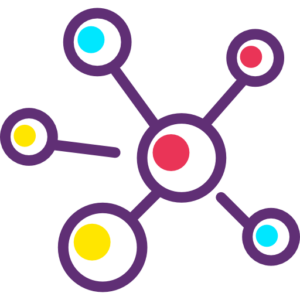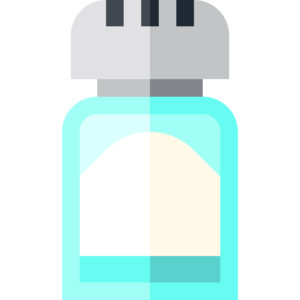Glutamate is one of our most important neurotransmitters in the brain, and it’s necessary for several vital bodily functions.
You’ve probably heard all the warnings about monosodium glutamate (MSG), but it’s not quite the same thing as the glutamate that’s naturally produced in our bodies.
That said, too much of it—via forms like MSG—may come with some unwanted side effects.
Here, we break down what glutamate is and why we need it, how it relates to MSG, and if you might be consuming too much of it.
What is Glutamate?

Glutamate (or glutamic acid) is one of the most abundant amino acids in the human body, and the most abundant neurotransmitter (chemical messengers that help cells communicate) in the brain.
It’s a non-essential amino acid, meaning our bodies are able to produce enough of it on their own. However, you can consume glutamate through a variety of foods.
Which Foods Contain Glutamate?
Foods naturally rich in glutamate are typically (but not always) high in protein, including:
- Meat
- Poultry
- Cheese
- Eggs
- Mushrooms
- Soy and soy sauce
- Tomatoes
- Grapes
- Fish sauce
- Broccoli
- Peas
- Walnuts
- Bone broths
Glutamate is also the main amino acid found in human breast milk, which points to its significance for brain development in infants (1).
Other foods, especially processed foods, contain a synthetic version called monosodium glutamate (MSG). We’ll get more into the controversy around MSG later.
What Does It Do?
As an amino acid, glutamate is used to build proteins, but it has another important job as a neurotransmitter.
Glutamate is mostly concentrated in the brain and central nervous system, and functions as an “excitatory” neurotransmitter.
Just as it sounds, an excitatory neurotransmitter “excites” or stimulates cells. Glutamate sends signals between nerve cells in the brain and body, and is especially vital for brain development, learning and memory.
It’s estimated that over half of all brain synapses (where communication between nerve cells happens) release glutamate (2).
Glutamate vs. Glutamine
It’s easy to mistake glutamate with glutamine, another important amino acid abundant in the body.
There’s a slight difference in the chemical structure of the two; Glutamine has an ammonia (-NH3) group rather than a hydroxyl (-OH) group.

The chemical structure of Glutamate

The chemical structure of Glutamine
Glutamine is also produced naturally in the body, but is considered a conditionally essential amino acid. This means, under certain conditions, like stress or major illness, you may need to obtain more of it through diet.
It’s found in several plant and animal proteins like meat, eggs, dairy, cabbage, tofu, beans and peas.
Glutamine is used to make glutamate, as well as the antioxidant glutathione, but it serves different purposes in the body (3).
Glutamine is mostly made and stored in muscle and plasma, and is important for the immune system and intestinal health. It’s even become a popular (but not necessarily proven effective) supplement for conditions like IBD and “leaky gut.”
Summary: Glutamate (or glutamic acid) is a non-essential amino acid, and the most abundant neurotransmitter (chemical messengers that help cells communicate) in the brain. It’s especially vital for brain development, learning and memory. While our bodies produce enough of it on their own, you can also consume glutamate in foods like meat, cheese, eggs and tomatoes. It’s also present in many processed foods in the form of MSG.
What is Monosodium Glutamate (MSG)?

Monosodium glutamate (MSG) is a food additive derived from glutamate, used to enhance the flavor of food.
MSG was developed in 1908 by Japanese biochemist Kikunae Ikeda, who wanted to identify the source of the rich taste of kombu, a type of seaweed. He managed to isolate glutamic acid and name its distinct taste “umami,” which essentially translates to “delicious.”
This umami taste (one of the five basic tastes along with sweet, sour, salty and bitter) helps balance and intensify flavors, just like naturally occurring glutamate found in foods like meats, cheeses, stews and bone broths.
MSG is a salt, a combination of sodium and glutamate. It’s produced by fermentation of starch or sugar.
It’s popular in Asian cooking and found in many packaged and processed foods, including stock (Bouillon) cubes, soups, ramen, condiments, dressings, salty snacks, frozen dinners and more.
The chemical structure of MSG is the same as the glutamate found naturally in most whole foods. However, the big distinction is that glutamate in MSG is “free,” or not bound to other amino acids.
That said, some foods naturally contain a form of MSG, or free glutamate, including tomatoes, potatoes, grapes and Parmesan cheese.
Without being bound within protein molecules, free glutamate may be absorbed much more rapidly, potentially leading to high concentrations in the blood.
Summary: MSG is a food additive derived from glutamate, used to enhance the flavor of food with its umami taste. It’s popular in Asian cooking and found in many packaged and processed foods. Glutamate in MSG is “free,” or not bound to other amino acids, so it may be absorbed more rapidly in the body.
Is MSG Bad?

MSG has long gotten a bad rap as a harmful additive, but much of the evidence doesn’t quite support the fears.
The U.S. Food and Drug Administration (FDA) states that MSG is “generally recognized as safe.” They say that “our bodies ultimately metabolize both sources of glutamate in the same way.”
The European Food Safety Authority (EFSA) has reached a similar conclusion. They allow glutamate additives at up to a maximum of 10 g/kg of food, and also offer an acceptable daily intake of 30 mg/kg body weight per day.
To give you an example of how much that is, there is roughly 1,400 mg of glutamic acid in two large cooked eggs (4).
Still, some people believe that MSG can lead to excessive amounts of glutamate in the brain. As an excitatory neurotransmitter, this means it could lead to overstimulation of nerve cells, and thus be an “excitotoxin” (5).
Indeed, too much glutamate in the the brain can lead to cell death, and has been linked to impaired spatial learning and symptoms of depression. It’s also been hypothesized that chronic excitotoxicity can play a role in neurodegenerative diseases like Alzheimer’s (6, 7).
However, MSG from the diet is likely not the cause of excitotoxicity from excessive glutamate. In fact, for the most part, it can’t cross the blood-brain barrier (BBB), even at high concentrations (8).
A recent study confirmed that, concluding that MSG in the diet does not raise the amount of glutamate in the brain or disrupt brain functions (9).
That said, some scientists theorize that people can have a leaky BBB, possibly caused from inflammation. This can potentially allow an excess amount of dietary glutamate into the brain (10).
This may be why some people are sensitive to MSG, and experience short-term symptoms like headache, numbness or flushing—though this is likely only after consuming high amounts of it (about 3 grams or more) (11).
As of now, there’s little evidence to prove that MSG affects the brain when consumed in normal amounts.
Summary: The FDA has deemed MSG safe, and research has shown that dietary MSG doesn’t raise glutamate levels in the brain. However, some people may be sensitive to MSG and experience short-term symptoms like headache and numbness, but only after consuming high amounts.
Health Benefits

Glutamate is the most important neurotransmitter in the brain, and it’s also crucial for a healthy gut, bones, muscles and immune system.
Here are some of its greatest health benefits.
1. Crucial for Brain Development and Function
As an excitatory neurotransmitter, glutamate sends signals throughout the brain and assists in cognitive functions like memory, learning and information processing.
In fact, it’s crucial in forming memories (12)
This likely comes from its role in regulating neuroplasticity, which allows the brain to change and adapt and strengthen the signals between neurons (13).
Glutamate and its transporters—which help provide glutamate for energy production, and remove excess levels in the brain—appear to be involved in almost all aspects of normal and abnormal brain activity (14).
Low (and sometimes high) levels of glutamate have been linked to schizophrenia and other psychiatric disorders like bipolar and major depression (15, 16).
This means that the neurotransmitter is vital, but too little or too much of it can negatively impact cognition as well as mood.
2. Produces GABA
Glutamate is necessary to produce another important neurotransmitter known as GABA (gamma-aminobutyric acid).
While glutamate is excitatory, GABA offers its balance as an inhibitory (or calming) neurotransmitter.
Just like glutamate, GABA is important for learning and brain development, as well as various functions in the central nervous system (17, 18).
But it works in an opposing way. GABA helps promote relaxation, and it can reduce anxiety and improve sleep ( 19, 20, 21)
Overall, it seems that a delicate balance of glutamate and GABA is essential to maintain homeostasis (a healthy state) in the brain and central nervous system (22).
3. Supports the Gut
The glutamate we acquire from food provides the gut cells with energy and helps activate the digestive system.
It’s the main energy source for the absorption and metabolism of nutrients (23).
Glutamate can also protect the gut lining by assisting in the production of the antioxidant glutathione (24).
One animal study found that L-glutamate supplementation helped improve the intestinal integrity in piglets, which was beneficial for digestion and absorption of nutrients (25).
Glutamate may also prevent gastrointestinal damage due to H. pylori and long-term use of NSAIDS (nonsteroidal anti-inflammatory drugs) like aspirin (26).
4. Essential in Immunity
Glutamate is also involved in functions within the tissues of the lungs, kidney, liver, heart, stomach, bones and immune system (27).
Glutamate receptors can be found in immune cells, including T cells. One study concluded that glutamate has potent effects on normal, as well as cancer and autoimmune pathological T cells. This means it may be able to boost beneficial T cell functions against cancer and infections (28).
These receptors also have the potential to inhibit the development of autoimmunity and protect from inflammation in the central nervous system, at least according to a study on a mouse model with multiple sclerosis (29).
Mostly, though, scientists have found that whether glutamate is beneficial or harmful to the immune system all depends on the amount concentrated in the body.
5. Important for Bones
Glutamate also works within bones and muscles, for both neural and non-neural signaling (30).
The neurotransmitter is important for the health of the bone and may play a role in potential treatment for a variety of bone diseases (31).
Summary: Glutamate plays several important roles throughout the brain and body. It’s crucial for brain development and forming memories, and in the production of another neurotransmitter called GABA. It also provides the gut cells with energy and is involved in functions within the tissues of the lungs, kidney, heart, bones and immune system.
Side Effects of Too Much Glutamate

While glutamate is necessary for survival, too much of it can be toxic and cause damage and potential death to nerve cells.
This can be caused from a high concentration or over-sensitive glutamate receptors (which require fewer molecules to “excite”).
But these high levels are likely not due to dietary glutamate, but rather other deficiencies or dysfunctions in the body.
Excess levels could be caused by things like stress, or an autoimmune reaction to the glutamic acid decarboxylase (GAD) enzyme, which is meant to convert glutamate into its calming companion GABA (32).
Too much glutamate in the brain has been associated with several neurological and mental health disorders, and has even been linked to chronic pain, migraines and diabetes.
1. Neurological Disorders
Too much glutamate may play a role in multiple sclerosis (MS), Alzheimer’s, Huntington’s disease, epilepsy and ALS (amyotrophic lateral sclerosis or Lou Gehrig’s disease).
In Huntington’s disease, sensitivity of glutamate receptors is a main characteristic. It’s been found that slowing activity of glutamate can have a therapeutic effect (33).
With ALS, which is thought to be caused by glutamate-induced excitotoxicity, drugs like riluzole attempt to control glutamate levels (34).
Dysfunction in the pathways involving glutamate can also contribute to the development of MS and Alzheimer’s disease, (35, 36).
2. Mental Health Disorders
Too much (or too little) glutamate is also linked to mental health disorders like depression and schizophrenia.
Numerous studies have discovered that high levels of glutamate or overactive glutamate receptors are often found in people who have major depression (37, 38).
There’s also a widespread hypothesis that excess (or insufficient) glutamate activity may cause schizophrenia symptoms (39).
However, it’s likely not that simple. Conflicting research in this area reveals that symptoms probably arise from a combination of neurotransmitter abnormalities (including glutamate), along with possible genetic mutations and other developmental problems (40).
3. Chronic Pain & Migraines
Glutamate also plays a pivotal role in pain sensation and transmission.
This means, chronic pain relief could be possible by targeting glutamate receptors and lowering glutamate’s impact (41).
There’s also a strong connection between high concentrations of glutamate and migraines (42).
One study found that plasma levels of glutamate were significantly higher in migraine patients (43).
Another study concluded that GABAergic drugs (those that modify the effects of GABA) may be useful in treating migraines (44).
Meanwhile, drugs that block glutamate receptors may also be effective in migraine treatment (45).
4. Diabetes
There’s even some evidence that, over time, high levels of glutamate could contribute to the development of both type 1 and type 2 diabetes.
One study found that glutamate levels showed both direct and indirect effects on the loss of beta cells in both types of diabetes (46).
Summary: Too much glutamate can be toxic and cause damage or death to nerve cells. This could contribute to neurological disorders like Alzheimer’s or MS, mental health disorders like major depression and schizophrenia, chronic pain, migraines and possibly even diabetes.
Should You Be Consuming More or Less Glutamate?
Glutamate is the most abundant neurotransmitter in the brain and one of the most important amino acids our bodies produce.
As an excitatory neurotransmitter, it’s vital for brain development, learning and memory, as well as other functions throughout the body.
While our bodies tend to produce enough on their own, we can also consume it via whole foods like meat, cheese, eggs and tomatoes. It’s also present in most packaged and processed foods in the form of MSG.
Glutamate in MSG is “free,” or not bound to other amino acids, so it may be absorbed more rapidly in the body. This is why many people fear that too much MSG could cause excitotoxicity in the brain, resulting in damaged nerve cells.
Excess glutamate can indeed be toxic and contribute to neurological disorders like Alzheimer’s and MS, mental health disorders like major depression and schizophrenia, chronic pain and migraines, and possibly even diabetes.
However, the fears over MSG causing this toxicity doesn’t match up with the evidence. Dietary glutamate in normal amounts doesn’t affect the levels in your brain, because it doesn’t cross the blood-brain barrier.
That said, you should be mindful of how certain foods that contain MSG make you feel, since some people can experience short-term symptoms. Some scientists believe this could be due to a possible leak in the blood-brain barrier.
Mostly, though, glutamate levels that are too high or too low are likely due to other deficiencies or dysfunctions in the body caused by things like stress or autoimmune reactions.
Overall, you shouldn’t be too concerned about the amount you consume. Normal bodies will produce enough of it and also keep any excess amounts out of the brain.
But if you notice any symptoms after consuming MSG, it wouldn’t hurt to reduce your consumption of processed foods. In fact, adding more whole foods in general (including those that naturally contain glutamate), is a good idea for everyone.
